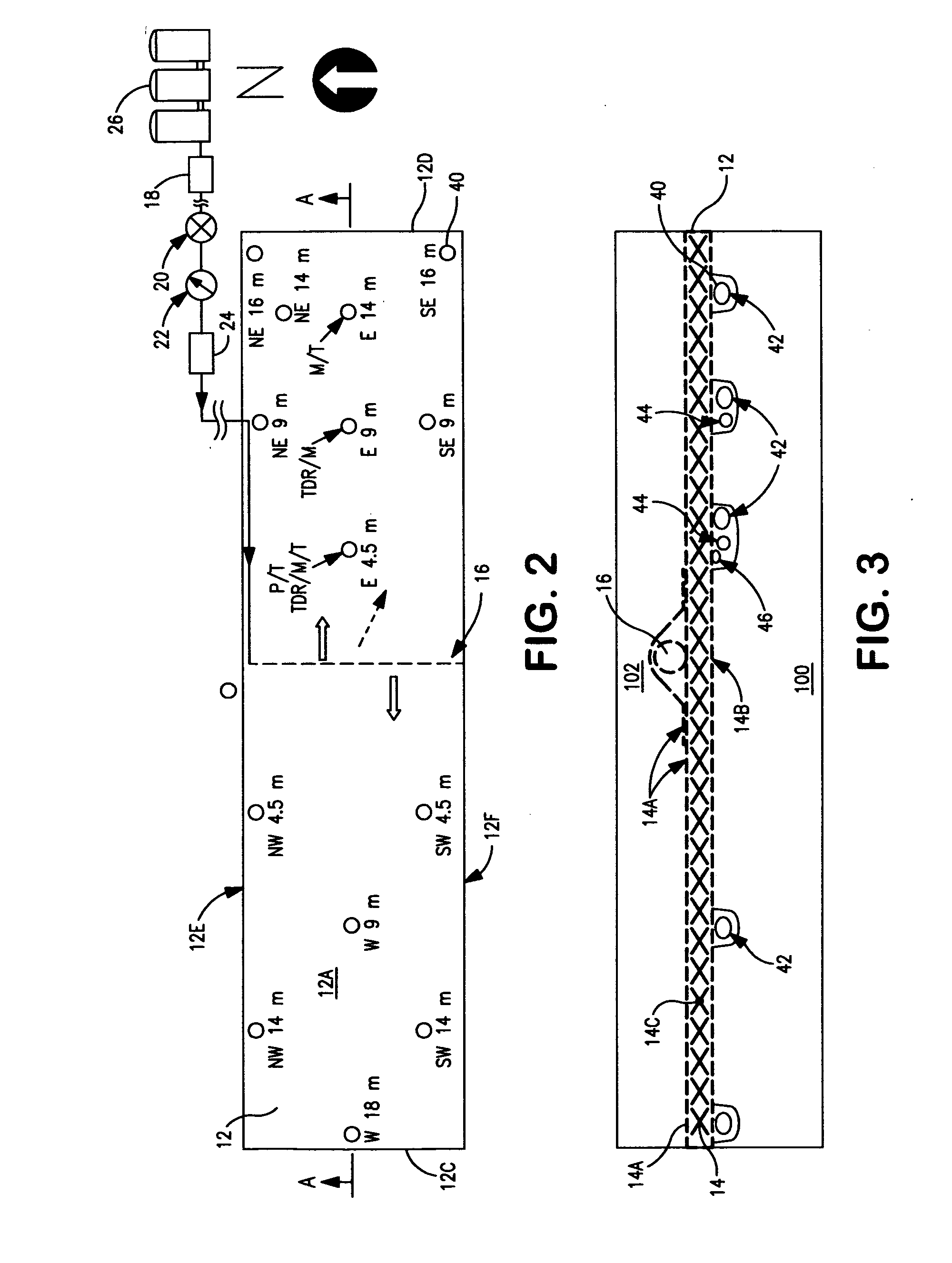Fluid distribution and collection in landfills and contaminated sites
a technology for contaminated sites and landfills, applied in nuclear engineering, radioactive decontamination, portable shielded containers, etc., can solve the problems of increased leachate head on the liner, increased slope stability of landfills, and potential flooding of the gas collection system, so as to reduce differential settlement and related post-closure maintenance costs, the effect of increasing the quantity
- Summary
- Abstract
- Description
- Claims
- Application Information
AI Technical Summary
Benefits of technology
Problems solved by technology
Method used
Image
Examples
example 1
[0078]In Example 1, where the permeable layer 112 was constructed of recycled, crushed glass, the permeable layer 112 had a thickness of about 0.15 m (0.5 ft).
[0079]The crushed recycled glass had an average particle diameter, D50 of approximately 10 mm (0.394 inches). The permeable layer 112 had a hydraulic conductivity equal to 3×10−2 m / s. The fluid injection and removal system was constructed by first leveling the waste surface. Next, a non-woven lower geotextiles fabric was laid on the waste surface. Below the lower geotextiles fabric, from top to bottom, was a layer of silty soil (loess) used as a daily soil cover having a thickness or depth of about 50 mm (2 inches), a layer of municipal solid waste having a thickness or depth of about 20 m (66 ft) and a leachate collection and lining system. A layer of crushed glass having a thickness or depth of about 0.15 m (0.49 ft) was placed on the geotextiles to form the permeable layer 112. An upper geotextiles fabric was then placed ab...
example 2
[0082]In Example 2, where the permeable layer 212 was constructed of shredded tires, the permeable layer 212 had an average thickness of about 0.5 m (1.6 ft). The perforated pipe was constructed of HDPE and was installed at the center of the permeable layer across the short side or width of the permeable layer and had a length of about 9 m (30 ft).
[0083]The data showing the response of impedance-based moisture sensors to the leachate injection in the shredded tires layer, showed that for a leachate injection rate of approximately 3.5 m3 / hr / m, the leachate traveled laterally in the shredded tires layer and reached the sensor located at approximately 15 ft (4.57 m) to the north of the injection pipe in about 2 to 3 minutes and reached the sensor located 23 to 27 m (75 to 90 ft) in about 20 to 25 minutes (FIG. 24). The data showed that for a leachate injection rate of 1.1 m3 / hr / m), leachate traveled laterally in the shredded tires layer and reached the sensors located at about 9 m (30 ...
example 3
[0084]In Example 3, the permeable layer 312 was a geocomposite drainage layer to be used to recirculate leachate. Table 1 sets forth the key properties of the components of the geocomposite drainage layer.
TABLE 1Physical Properties of the Geocomposite Drainage LayerUpperLowerComponentGeotextileGeotextileGeonetTypeNon-WovenWoven—Thickness (mm) (ASTM D 5199)20.55Mass per Unit Area (g / m2) (ASTM D270200—5261)Transmissivitya (cm2 / s) (ASTM D——204716-00)Permittivity (s−1) (ASTM D 4491)1.51.1—Hydraulic Conductivity (cm / s)0.30.05—(ASTM D 4491)Apparent Opening Size (mm)0.180.6~12.5(ASTM D 4751)Percent Open Area (%) (CW-02215)—1180Note:agradient of 0.1, normal load of 480 kPa, water (permanent) at 20° C., between steel plates for 15 minutes.
[0085]Before placing the geocomposite drainage layer, the surface of the landfill cell was essentially leveled. A topographic survey of the geocomposite drainage layer conducted after the placement of the geocomposite drainage layer indicated that the groun...
PUM
 Login to View More
Login to View More Abstract
Description
Claims
Application Information
 Login to View More
Login to View More - R&D
- Intellectual Property
- Life Sciences
- Materials
- Tech Scout
- Unparalleled Data Quality
- Higher Quality Content
- 60% Fewer Hallucinations
Browse by: Latest US Patents, China's latest patents, Technical Efficacy Thesaurus, Application Domain, Technology Topic, Popular Technical Reports.
© 2025 PatSnap. All rights reserved.Legal|Privacy policy|Modern Slavery Act Transparency Statement|Sitemap|About US| Contact US: help@patsnap.com



